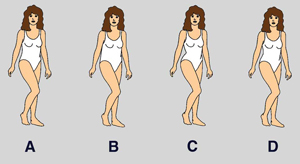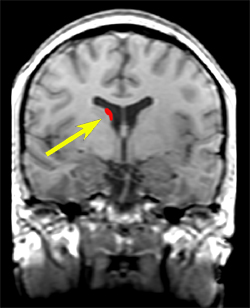| Scientists
have now discovered that there are three separate sex drives that
control the rules of the mating game.
by Stuart Carter

First date
excitement: is it lust, love or more?
|
|
You may have heard it all before: men are turned on visually and women are more interested in character. Perhaps this is the basis of attraction, but it's never that simple: both sexes want sex and love and often go to great lengths to get it. The primitive urge to have sex often gets more complicated as people wonder if casual sex is turning into a relationship, or whether they should break up with a long-term partner. Why do we want sex and love that badly and what determines attraction? Recent research shows that there are three different drives involved: lust, love and attachment.
First, there is lustā€¦
To shed some light on the "visual stimuli" that fire-up a man's brain-cells, researchers from the University of Texas at Austin conducted a classic psychology experiment. They showed a group of men line drawings of female bodies. The size of the waist and the size of the hips were marginally different in every picture, sex researchers refer to this relationship as the 'waist-to-hip' ratio. A clear majority of the men preferred female C: a woman whose waist is precisely seven-tenths the size of her hips. It turns out that women with this waist-to-hip ratio get pregnant more easily, have fewer miscarriages and are more likely to give birth successfully. Hip and waist size, full lips, defined cheeks, and sizable breasts are all controlled by sex hormones.

The hip-to-waist
ratio of female C is the most desirable to men.
|
The human body is a walking billboard for our hormones: in women oestrogen and in men testosterone. Secreted primarily by the ovaries, oestrogen influences not only the menstrual cycle but also the development of a woman's face and body shape when she goes through puberty. Scientists theorise that men are attracted to women whose features indicate high hormonal levels because it offers the promise of bearing healthy children. When a boy reaches puberty, testosterone promotes the growth of particular masculine features such as prominent cheekbones, a strong jaw and broad shoulders. These masculine features are markers for virility and health. For humans to survive and prosper, we need healthy offspring with favourable genes and a strong immune system.
Scientists are now conducting new experiments to decipher more and more of the coded signals our bodies send out to attract a partner. At the University of New Mexico, researchers believe that our nose interprets signals in mere milliseconds without us being aware that we're doing it. They got athletes to exercise and then gave their sweaty shirts to female biology students to sniff. What they smelt were the men's pheromones: airborne molecules exuded from their sweat glands. The women had no idea which shirt belonged to which athlete. They discovered that the female students preferred the smell of men that had a major histocompatibility complex, or MHC, that was different from their own. This group of genes plays an important role in the body's defence system, and favouring guys whose immune system is unlike their own makes good evolutionary sense.
But our noses can detect more than just different genes: they can also detect symmetry. It may seem bizarre, but women prefer the smell of men who are more symmetrical. The fact that symmetry attracts the opposite sex is nothing new, it was first noted by researchers in the 1990s. In the study, women selected pictures of men they found most attractive. When they analysed blood from the men they chose as the most attractive they found a greater variety of genes, and hence a stronger immune system. But no one quite knows how our faces convey this information.
Lust can often lead to romance and then loveā€¦.

Love causes
a lot of activity in the caudate area of the brain where
there is a dense area of dopamine receptors.
|
We don't just mate with anyone. Usually
our brain makes us focus our attention on just one individual. What
fuels this passion for one person is romantic love - that feeling
of ecstasy so potent it should carry a health warning. Romantic
love is not a fanciful notion - it's scientifically measurable.
If you've ever been in love, you know what an overpowering emotion
it can be.
Scientists have analysed the blood flow through the brains of students who are self-confessedly deeply in love and what they discovered was that being in love affects the brain in much the same way as using certain illegal stimulant drugs! The brain areas concerned have a high concentration of receptors for the hormone dopamine. Dopamine is a neurotransmitter that is involved in the control of fine motor co-ordination, short-term memory and emotions such as sexual desire. It is one of the body's 'feel good' chemicals. Elevated levels of dopamine produce extremely focused attention and unwavering motivation, the very characteristics of romantic love. Heightened dopamine levels explain why love stricken men and women become so dependent on their relationship and why they crave to be with their partner - at least long enough to get the female pregnant. Sexual bonding leads to repeated copulation and that leads to offspring. The desire to fall in love seems to be a basic human need across all cultures. In fact, love is even more powerful than sex: some people commit suicide or commit murders when they are rejected in love. Romantic love remains a universal experience deeply woven into the fabric of the human brain.
Time for a relationship?
Once you've chosen your mate - and fallen in love - will you stay together? It makes evolutionary sense for couples to stay together after they've had children to help raise them. It's the body's natural love potion that sticks a couple together like glue. It comes into play when a couple has sex and a chemical called oxytocin is released. This hormone and neurotransmitter produced in the brain acts as a sexual arousal hormone that signals orgasm and prompts cuddling between lovers before, during, and after intercourse. One theory is that the more sex a couple has with each other, the more oxytocin is released and the deeper their bond becomes. As soon as you have sex with someone you are playing with fire: even if you didn't really fancy them at first you may find that you are creating an unbreakable bond.
There is one last important drug in the pharmacy of love: vasopressin. Also released during sex, it plays a critical role in the long-term commitment stage. Research into the mating habits of prairie voles, who are among the three percent of mammals that mate for life, revealed that vasopressin is released when they mate. The same thing happens in humans, and it stimulates the 'reward' part of our brain, creating a type of addiction. Just like lust and romantic love, forming a lasting loving relationship is a matter of chemistry.
The chemicals that flood our brain and our very physiology all serve one purpose: the continuation of our species. Once we have children, these chemicals alter to encourage us to stay together and raise them. Sex, lust and love, are the result of an intoxicating hormonal mix designed to encourage human reproduction. And this chemical cocktail really does make the world go round.
For more info:
The Science of Attraction
http://www.students.emory.edu/HYBRIDVIGOR/issue1/attraction.htm
The Rules of Attraction in the Game of Love
http://news.yahoo.com/s/space/20060213/sc_space/therulesofattractioninthegameoflove
|
